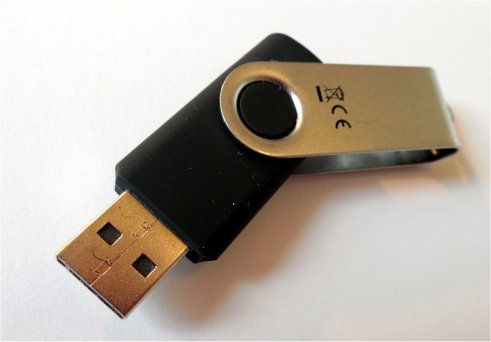Flash memory is a type of non-volatile memory (it keeps its content even when powered down). Unlike ROM, flash memory can be read and written. It is like a non-volatile type of RAM.
Flash memory is often used as a fast, solid state alternative to a disk drive. It is faster than a hard drive, but not as fast as system RAM. Flash memory is generally packaged as either:
- A USB memory stick.
- A memory card (SD card).
- A solid state drive (SSD), discussed more here.
USB memory sticks
A USB memory stick consists of some flash memory and a USB plug, built into a small case:

The item is small and light enough to carry in your pocket (sometimes on a keyring), and can be easily inserted into a USB port to copy files to and from a computer. This makes it a very convenient device for transferring data between different computers, or carrying data with you.
They very is size from a few GB, which cost a few pounds, right up to sizes which are almost the capacity of a hard drive (but more expensive).
They are also sometimes used for backups, although they can be quite fragile if dropped (the memory itself is quite robust, but the soldered connections sometime break). It is also quite easy to accidentally overwrite them, or just plain lose them, so they shouldn't be used as the only backup of important data.
Memory sticks are sometimes called Thumb Drives.
Memory cards
A memory card consists of some flash memory in a thin plastic case, with metal plates on the side to connect to it. It is basically the same as a memory stick, but without the USB connector or case.
Several styles of memory cards were used when flash memory first become popular, but these days SD (Secure Digital) cards are the most used standard. Here is a Micro SD card:

The cards are designed to be used in portable devices such as phones, tablets and digital cameras. People often talk about adding extra "memory" to their phone, but in fact memory cards are used as secondary storage, so it is equivalent to adding a larger hard drive.
There are 3 sizes, the standard SD card (32 by 24 mm, about 2 mm thick), the mini, and the micro (15 by 11 mm and 1 mm thick). The micro size is now commonly used for phones.
Copyright (c) Axlesoft Ltd 2021